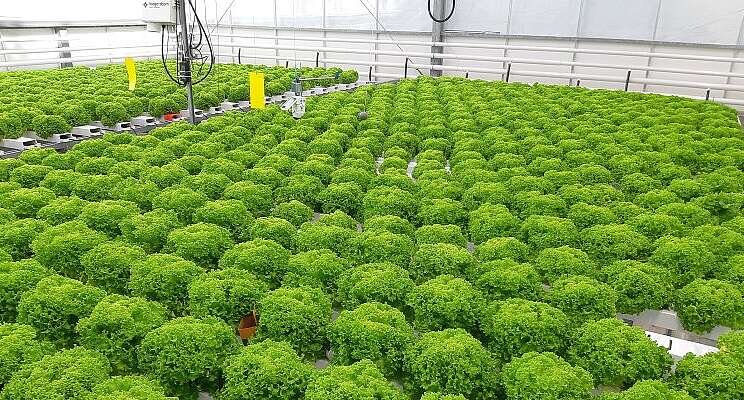Succesfull first try-out with autonomous lettuce growing
Added on 11 April 2022

The goal of the 3rd Autonomous Greenhouse Challenge is to grow lettuces in two crop cycli fully autonomously with an AI algorithm on a cloud platform with good quality and little resource and energy use and without any human interference in the experimental greenhouses of Wageningen University & Research in Bleiswijk.
What has been done?
The first crop cycle of the 3rd Autonomous Greenhouse Challenge started on February 2nd with the planting of cultivar Salanova. Five teams (Team CVA, Team digital_cucumber, Team MondayLettuce, Team VeggieMight, Team Koala) participated in the first try-out experiment to test theiralgorithms and gain experience. The reference greenhouse was operated by WUR organisers. The goal was to maximize net profit of the lettuce cultivation.
Each team had a 96 m2 compartment at its disposal in the high-tech greenhouses of Wageningen University & Research in Bleiswijk with standard climate sensors and equipment. The teams' algorithms had to determine the set points for temperature, amount of daylight and artificial light, heating, CO2 concentration and cultivation-related parameters such as crop density. Vision technology provided the teams with on-line status information.The teams' algorithms were mounted on a virtual machine on a protected WUR server. Data from the greenhouse is received via a digital interface from LetsGrow and Azure Cloud. At the same time, the algorithms autonomously send setpoints back to the process computer, which ultimately takes the action on climate control in the experimental greenhouse.
Different strategies lead to interesting learnings
Teams followed different climate strategies, varying in temperature, assimilation additional LED-light and CO2 application. This resulted in different growth duration, use of resources and lettuce head weights. For example, average temperature varied between 18.9 and 21.9oC, and daily amounts of PAR light varied between 9.1 and 16.3 mol/m2/day. Also crop spacing strategies varied, resulting in averages plant densities from 24 to 38 plants/m2. As a result, growth duration varied: dates of harvest ranged from March 10 to March 21, and average plant weight at harvest varied from 138 to 320 g.
Apart from the weight, the quality of the lettuce head is important to determine the price. Lettuce heads were classified in three categories: class A for lettuce heads heavier than 245 g, class B for lettuce heads between 220 and 245 g, and class C for lettuce heads lighter than 220 gand/or with poor quality such as tip burnoforbotrytis. For some teams, tip burn and botrytis were very severe. The experiments showed that high radiation and temperature levels were associated with high levels of tip burn.
Photo Courtesy of Wageningen University & Research
Source: Wageningen University & Research
More news















